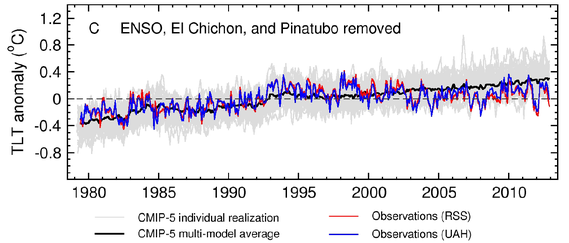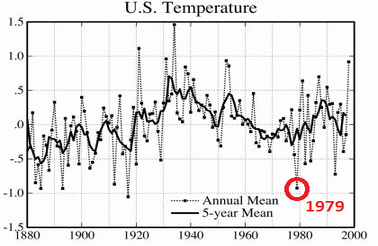The models run hot
Here's a 2014 paper by LLNL's Ben Santer and many co-authors:
http://dspace.mit.edu/handle/1721.1/89054
They sought to "subtract out" the effects of ENSO and the Pinatubo (1991) & El Chichón (1982) volcanic aerosols, from measured (satellite) temperature data, to find the underlying temperature trends. Here's a graph from their paper (click to enlarge):
Two things stand out:
1. The models run hot. The CMIP5 computer models (the black line), which are tuned with the assumption that at least 100% of 20th century warming is anthropogenic, and an average ECS climate sensitivity of about 3.0°C per doubling of CO2, show a lot more warming than the satellites. The models predict about 0.20°C/decade warming over the 34-year measurement period, but the satellites measured only about half that. And,
2. The “pause” began around 1993. The measured warming is all in the first 14 years (1979-1993). Their graph (with corrections to compensate for both ENSO and volcanic forcings) shows no noticeable warming since then (1994-2013).
Also, although the Santer graph still shows an average of about 0.10°C of measured warming per decade, that's partly because it starts in 1979. The late 1970s were the frigid end of an extended cooling period in the northern hemisphere, as you can see in this graph of U.S. temperatures, from a 1999 Hansen/NASA paper:
(Note: much of that 1940s–70s cooling trend has been erased by subsequent adjustments.)
Christy & McNider (2017) (or preprint) did a similar exercise, and found a similar rate of warming (0.096°C/decade), and calculated a tropospheric TCR climate sensitivity of +1.10 ±0.26 °C per CO2 doubling, about half the average IPCC AR5 estimate. The paper is quite long, but here's a readable discussion.
The fact that when volcanic aerosols & ENSO are accounted for the models run hot by about a factor of two is evidence that the IPCC's estimates of climate sensitivity are high by about a factor of two, which suggests that a substantial part, perhaps half, of the global warming since the mid-1800s, was natural, rather than anthropogenic.
That's consistent with a TCR sensitivity of under 1.0°C, and an ECS sensitivity of perhaps 1.5°C, which most scientists would agree is not enough to worry about.
See also:

